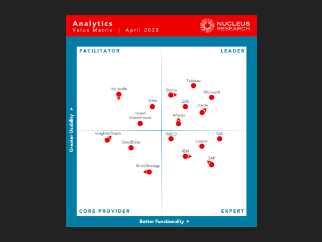Business intelligence tools for sales reps: How to use KPIs to increase effectiveness
Sales leaders are nothing without a proper understanding of their team’s performance. When sales reps don’t hit their quotas, the finger is often pointed at them. But what if there was a tool sales leaders could use to help their reps succeed?
Business intelligence (BI) tools can provide tremendous value to sales leadership. By creating an executive sales dashboard using a BI tool, sales leaders can easily track the performance of their team and see where they need to make changes.
Sales success depends on capturing data that is relevant to your business goals and turning it into insights. KPIs (key performance indicators) play a critical role in this process by helping you focus on the most important data.
So how can you use KPIs to improve the performance of your sales reps? And how can BI tools help you do that?
In this article, we will take a look at how sales reps can use KPIs to increase their effectiveness and how BI tools can help sales leaders track the performance of their teams.

Why KPIs matter in sales
The goal of any sales organization is to make as much money as possible in accordance with the goals set by their management. To do this, they need to have a process in place that allows them to track their progress and make changes as needed.
A KPI is a metric that helps you understand how well your sales organization is performing with respect to your goals. There are different types of KPIs, but the most important for sales reps are activity-based KPIs and outcome-based KPIs.
Activity-based KPIs
Activity-based KPIs focus on measuring the amount of work that is being done by sales reps. These KPIs can include things such as the number of calls made, emails sent, or leads generated.
Outcome-based KPIs
Outcome-based KPIs, on the other hand, focus on measuring the results of a sales rep’s efforts. These KPIs can include things such as the revenue generated, a number of closed deals, or customer satisfaction.
Both types of KPIs are important, but outcome-based KPIs are more important because they tell you how well your sales reps are performing in relation to your goals.
KPIs measure progress
You can’t improve what you can’t measure, and that is why KPIs are so important in sales. By tracking the progress of your sales reps against your goals, you can identify areas where they need improvement and make the necessary changes.
But how do you go about setting up KPIs for your sales reps? And how do BI tools fit into the equation?
How to set up KPIs for sales reps
The first step in setting up KPIs for your sales reps is to determine what goals you want them to achieve. These goals should be aligned with the overall business strategy of your company. Once you have determined your goals, you need to come up with a way to measure them.
This can be done by using the following formula:
Goal = (desired outcome) / (measurement metric)
For example, if you want your sales reps to generate $1 million in revenue, your goal would be $1 million / (measurement metric). The measurement metric could be the number of leads generated, the number of deals closed, or the amount of revenue generated.
Once you have determined your goal and the measurement metric, you can then set up KPIs to track the progress of your sales reps.
Here are a few tips for setting up KPIs:
Keep it simple
You want your sales reps to focus on their goals, not on the KPIs that are being used to track their progress. Keep your KPIs simple and easy to understand.
Make it relevant
The KPIs you choose should be relevant to the goals you are trying to achieve.
Make it achievable
Your sales reps should be able to achieve their KPIs with a reasonable amount of effort.
Make it time-based
Your KPIs should be set up to measure the progress of your sales reps over a given period of time.
BI tools can help you track the progress of your sales reps against your goals by providing insights into their activity and outcome-based KPIs.

How BI tools help sales leaders track the performance of their team
A sales dashboard is a visualization of the data that is most important to sales leaders. It can provide insights into how well their team is performing in relation to their goals.
BI tools can help you create an executive sales dashboard by providing you with the ability to track the performance of your sales reps against your goals. The data that is included in a sales dashboard can vary depending on the needs of the sales leader, but it typically includes information such as:
- The number of leads generated
- The number of deals closed
- The amount of revenue generated
- The average deal size
- Customer satisfaction ratings
- The number of calls made
- The number of emails sent
- The number of voicemails left
- The number of appointments booked
BI tools can also help you track the performance of your sales reps in relation to your goals by providing insights into their activity-based and outcome-based KPIs.
Sales leaders can use this data to make informed decisions about how to improve the performance of their team. The key is to pull the data together into a single dashboard that provides a snapshot of the performance of your team.
Building a KPI dashboard for sales reps
A KPI dashboard is a visualization of the data that is most important to sales reps. It can provide insights into how well they are performing in relation to their goals. Building one will depend on the BI tool that you are using.
Most BI tools will allow you to create a dashboard that includes the data that is most important to you. This data can be filtered by time period, goal, or measurement metric.
Here are some tips on how to build a KPI dashboard for your sales reps:
1. Start with your KPIs
The first step is to determine which KPIs you want to track. You can track the progress of your sales reps against their goals by using outcome-based or activity-based KPIs.
2. Filter the data by time period
Next, you need to filter the data by time period. This will allow you to see how your sales reps are performing over a given period of time.
3. Add in the goal
Once you have filtered the data by time period, you need to add in the goal. This will allow you to see how your sales reps are performing in relation to their goals.
4. Add in the measurement metric
Finally, you need to add in the measurement metric. This will allow you to see how your sales reps are performing in relation to the metric you have chosen to track.
5. Distribute the data
Once you have created your KPI dashboard, you can export it as a PDF or Excel file. This will allow you to share it with your sales reps or other members of your team.
6. Update the dashboard regularly
You should update your KPI dashboard regularly to ensure that it is reflective of the current performance of your sales reps.

How sales reps can use their BI tool to improve their performance
Once you have created a KPI dashboard for your sales reps, they can use it to improve their performance.
Here are some tips on how sales reps can use their BI tool to improve their performance:
1. Set Goals
The first step is to set goals. Your BI tool will allow you to track the progress of your sales reps against their goals. This will help them stay on track and achieve their desired outcomes.
Goals may include:
- Making a certain number of calls
- Sending a certain number of emails
- Booking a certain number of appointments
2. Analyze activity-based KPIs
Sales reps can use their BI tool to analyze their activity-based KPIs. This will allow them to see how they are performing in relation to their goals.
As they track their goal-based data, they can use it to adjust their activity-based KPIs. This will help them improve their performance over time.
3. Analyze outcome-based KPIs
Sales reps can also use their BI tool to analyze their outcome-based KPIs. This will allow them to see how they are performing in relation to their goals.
This data can help them identify areas where they need to make adjustments in order to improve their performance.
4. Compare performance against peers
Sales reps can also use their BI tool to compare their performance against their peers. This will allow them to see how they are performing in relation to other members of their team.
This data can help them identify areas where they need to improve in order to stay competitive.
5. Get feedback
Sales reps can use their BI tool to get feedback from their manager or other members of their team. This will allow them to get insights into how they can improve their performance.
Conclusion
Sales reps are a vital part of any business. In order to ensure that they are performing at their best, businesses need to use KPIs and business intelligence tools.
The KPI dashboard that you create for your sales reps will allow them to track their progress against their goals. They can use this data to improve their performance over time, as well as compare their performance against their peers.
You should update your KPI dashboard regularly to ensure that it is reflective of the current performance of your sales reps. Only when sales reps have access to timely and accurate performance data can they hope to improve their productivity—and their bottom line.
Check out some related resources:

Unlocking the Future of Software with Analytics

10 Qlik Alternatives & Competitors in 2025






